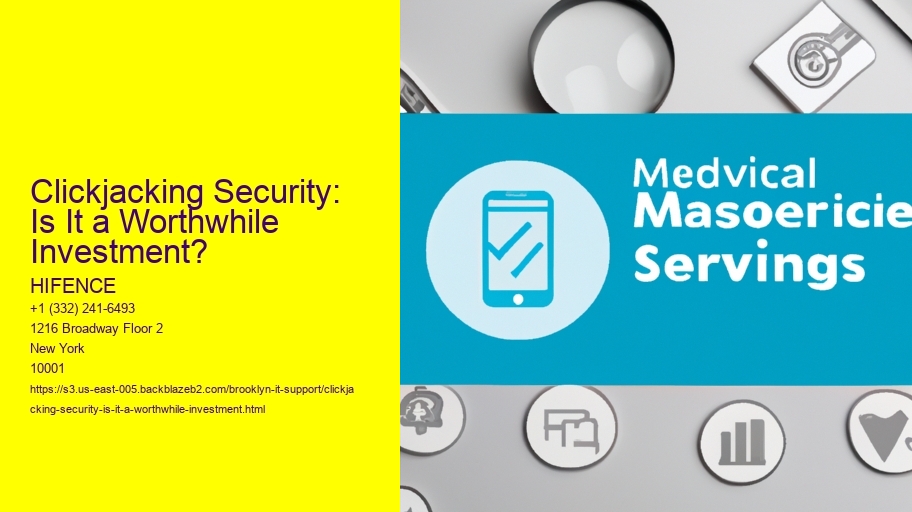
Clickjacking: Is Protecting Against It Really Worth the Effort?
Clickjacking. It sounds like something out of a cyber-pirate movie, doesnt it? But its a real threat, and understanding how it works is the first step in figuring out if beefing up your clickjacking security is a worthwhile investment.
So, how does this “clickjacking” thing work? Imagine youre browsing a seemingly innocent webpage. Maybe its a fun quiz or a harmless-looking forum. Unbeknownst to you, lurking beneath the surface is a malicious layer (an iframe, to be precise). This layer subtly overlays legitimate elements of the webpage, tricking you into clicking something you didnt intend to. Perhaps you think youre clicking a "Like" button (a genuine action), but in reality, youre authorizing a payment, changing your privacy settings, or even granting access to your webcam! Eek!
The attacker essentially hijacks your clicks (hence, "clickjacking"). They're exploiting the fact that you, the user, trust the visual presentation of the webpage. You believe you're interacting with one thing, when actually, youre interacting with something completely different. It's a nasty trick that relies on the users lack of awareness.
Now, the big question: Is protecting against this threat truly important? Well, it depends. For websites handling sensitive user data (think banking sites, social media platforms, e-commerce sites), the answer is a resounding YES! The potential damage from a successful clickjacking attack can be significant, ranging from financial losses and reputational damage to privacy breaches and account compromise. You cant afford not to protect your users.
However, for simpler websites that dont handle sensitive information, the risk might be lower. That doesn't mean you should disregard it entirely, but the level of investment might be different. Are there other bigger fish to fry? Maybe.
Implementing clickjacking defenses, such as X-Frame-Options headers or Content Security Policy (CSP) directives, isnt usually terribly complex or expensive. These (relatively simple) measures can drastically reduce the risk, so it often makes sense to implement them as a baseline security practice.
Ultimately, the decision about whether to invest in clickjacking security requires a careful assessment of your websites specific risk profile. Consider the sensitivity of the data you handle, the potential impact of a successful attack, and the cost of implementing security measures. Its about finding the right balance. Dont be complacent, but dont break the bank over something that isnt a significant danger. Do your homework, and you'll make the right call.

Clickjacking Security: Is It a Worthwhile Investment?
Real-World Examples and the Impact of Clickjacking Attacks
So, is investing in clickjacking security really worth it? Well, consider this: clickjacking, though often overlooked, isnt just some abstract threat.
Think about it: someone visits what appears to be a harmless website. Unbeknownst to them, invisible layers are subtly placed over legitimate elements. They click what they think is a button to, say, watch a video, but they're actually authorizing a payment, changing their privacy settings, or even liking a Facebook page for something completely inappropriate. (Can you imagine the embarrassment?)
There have been documented cases of clickjacking being used to spread malware, hijack social media accounts, and even manipulate online banking transactions. These arent hypothetical scenarios; theyre things that have actually happened. The impact? Well, it varies. For individuals, it could mean financial loss, reputational damage, or even identity theft. For businesses, it could mean a damaged reputation, loss of customer trust, and significant financial penalties. (Ouch!)
The thing is, clickjacking attacks can be incredibly subtle, and users often have no idea theyve been targeted until it's too late. Thats why preventative measures are so important. Its not about eliminating all risk (thats probably impossible, let's be honest), its about significantly reducing the likelihood of an attack and minimizing the potential damage. Ignoring this threat definitely isnt a smart move. managed service new york Its a gamble, and one youre likely to lose.
Clickjacking Security: Is It a Worthwhile Investment?
Clickjacking, a sneaky (and frankly, annoying) web security vulnerability, tricks users into unknowingly performing actions they didnt intend. You might think youre clicking a harmless button, but really, youre agreeing to something far more sinister – liking a malicious post, changing your password, or even transferring funds! So, is investing in clickjacking security worth the effort? Id argue it absolutely is.

Clickjacking Mitigation Techniques: A Comprehensive Overview
Think of clickjacking mitigation as your websites defenses against these deceptive attacks. There isnt a single, silver-bullet solution; instead, a multi-layered approach is needed. One crucial defense is the X-Frame-Options (XFO) header. This header allows you to control whether your site can be embedded within an